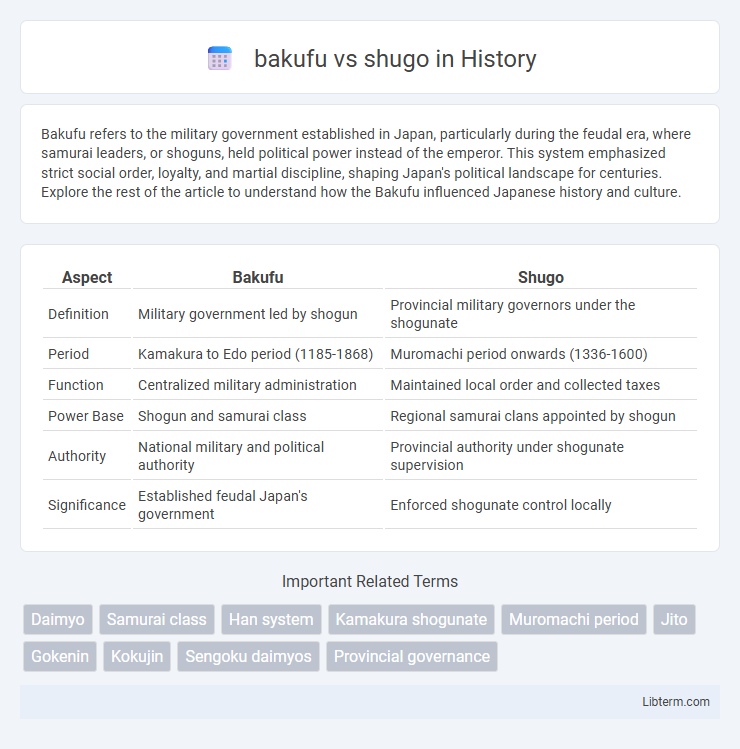Bakufu refers to the military government established in Japan, particularly during the feudal era, where samurai leaders, or shoguns, held political power instead of the emperor. This system emphasized strict social order, loyalty, and martial discipline, shaping Japan's political landscape for centuries. Explore the rest of the article to understand how the Bakufu influenced Japanese history and culture.
Table of Comparison
| Aspect | Bakufu | Shugo |
|---|---|---|
| Definition | Military government led by shogun | Provincial military governors under the shogunate |
| Period | Kamakura to Edo period (1185-1868) | Muromachi period onwards (1336-1600) |
| Function | Centralized military administration | Maintained local order and collected taxes |
| Power Base | Shogun and samurai class | Regional samurai clans appointed by shogun |
| Authority | National military and political authority | Provincial authority under shogunate supervision |
| Significance | Established feudal Japan's government | Enforced shogunate control locally |
Introduction: Understanding Bakufu and Shugo
The Bakufu, or shogunate, was the military government led by the shogun, holding central political and military power in feudal Japan. Shugo were provincial military governors appointed by the Bakufu to maintain order and collect taxes in their respective regions. The dynamic between the Bakufu's central authority and the shugo's regional control shaped the political structure and governance during the Kamakura and Muromachi periods.
Historical Background of Bakufu and Shugo
The Bakufu, or shogunate, was a military government established in feudal Japan that centralized power under the shogun, while the Shugo were provincial military governors appointed by the Bakufu to maintain order and collect taxes. Originating during the Kamakura period (1185-1333), the Bakufu wielded political and military authority, overshadowing the imperial court. Shugo played a crucial role in local governance, serving as intermediaries between the central Bakufu and regional samurai clans, which laid the foundation for Japan's feudal administrative structure.
The Role and Structure of the Bakufu
The Bakufu, or shogunate, operated as Japan's military government, centralizing authority under the shogun with a hierarchical structure that included appointed officials such as the shugo, who served as provincial governors. Unlike independent feudal lords, the shugo functioned as representatives enforcing the Bakufu's policies, overseeing military, judicial, and tax duties within their regions. This system ensured the Bakufu maintained direct control over local administration while delegating governance through a network of loyal retainers.
Functions and Authority of Shugo
Shugo were military governors during the Kamakura and Muromachi periods in Japan, tasked with maintaining public order, overseeing the samurai, and managing provincial administration. Their authority included tax collection, law enforcement, and commanding local military forces on behalf of the bakufu, which held centralized political power. While the bakufu exercised national governance and policy-making, shugo operated as regional agents implementing central directives and controlling local domains.
Key Differences Between Bakufu and Shugo
Bakufu refers to the military government led by the shogun, holding centralized power and overseeing national military and political administration during feudal Japan. Shugo were provincial military governors appointed by the bakufu to maintain law, collect taxes, and enforce military control at a regional level. The key difference lies in bakufu's role as the central authority establishing national policies, whereas shugo acted as local enforcers executing the bakufu's directives within their assigned provinces.
Political Influence and Military Power
The Bakufu, or shogunate government, centralized political power by controlling military forces and appointing regional governors, effectively holding national authority during feudal Japan. Shugo were provincial military governors appointed by the Bakufu, acting as intermediaries to enforce law and order while managing local samurai retainers and land assessments. The Bakufu's superiority in commanding large-scale armies and governing broader territories distinguished its political dominance from the more localized military and administrative role of the Shugo.
Relationships With the Emperor and Court
The bakufu, or shogunate, maintained a military government with a pragmatic yet distant relationship to the emperor, often exercising de facto political power while legitimizing authority through imperial sanction. Shugo, as provincial military governors appointed by the bakufu, operated under the shogunate's authority but played key roles in local administration and security, indirectly influencing the imperial court's interests through regional control. The emperor and court held symbolic and religious significance, with the bakufu leveraging this prestige to consolidate governance, whereas shugo's ties to the court were limited and primarily mediated through the shogunate's centralized power.
Regional Governance and Administration
The Bakufu, or shogunate, centralized military power and established a hierarchical structure controlling national policies, while the Shugo operated as regional military governors with delegated administrative authority over provinces. Shugo managed local law enforcement, tax collection, and military conscription, acting as intermediaries between the Bakufu and local samurai. This system allowed the Bakufu to maintain strong regional governance through the Shugo's enforcement of loyalty and order across diverse territories.
Impact on Feudal Japanese Society
The Bakufu system centralized military and political power under the shogun, diminishing the influence of local shugo governors who traditionally managed provinces. This shift reinforced the shogunate's dominance, transforming the feudal hierarchy by curbing regional autonomy and consolidating authority within the military government. Consequently, the balance of power shifted significantly, shaping Japan's political structure and social order during the Muromachi and subsequent periods.
Legacy and Historical Significance
The Bakufu established centralized military governance during Japan's feudal era, significantly shaping the political landscape through the shogunate system, which maintained order and delegated authority to regional military governors called Shugo. Shugo wielded local power by managing provinces, collecting taxes, and commanding military forces, serving as crucial intermediaries between the shogunate and regional domains. This dynamic laid the foundation for Japan's decentralized feudal hierarchy, influencing future governance structures and legacies in Japanese history.
bakufu Infographic

 libterm.com
libterm.com